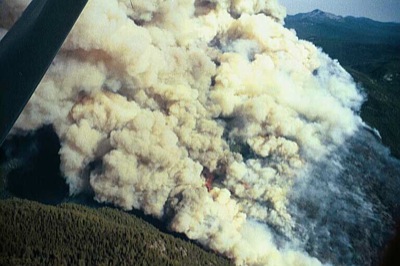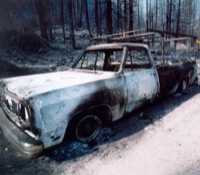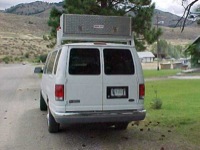Nothing in the history of the Forest Service has more of an emotional impact on the agency than the deaths of multiple firefighters burned in the fires they are trying to suppress. The sudden end to such young lives while performing heroic deeds can shake the agency to its core. Former Forest Service Chief Jack Ward Thomas says that the worst day of his professional life was when 14 firefighters were killed in a 1994 Colorado fire.
But as traumatic as fire-related deaths are, a bureaucracy is driven by dollars, not emotion. Since the Forest Service’s dollars come from the top, it seems to be unable to learn the lessons being taught by deaths at the bottom.
In July, 2001, some unknown campers failed to put out their fire after grilling some hot dogs in northern Washington’s Okanogan National Forest. The fire was spotted creeping through the grasses of the Chewuch River Research Natural Area on the evening of July 9, and an elite “hotshot” crew was dispatched to put it out.
The next morning, a rookie-laden “regular” crew was sent out for what was supposed to be routine mop-up operations. But the fire blew up and killed four of the firefighters, two of them teenage girls.

The Thirtymile Fire burns over the location of fourteen firefighters trapped up a dead-end road.
The Thirtymile Fire: A Chronicle of Bravery and Betrayal is John MacLean’s account of the fire and its aftermath. MacLean is the son of Norman MacLean, who wrote A River Runs Through It. John edited Norman’s posthumously-published book, Young Men and Fire, and has written two other books on fire, most notably Fire on the Mountain, which is about the 1994 fire that killed 14 firefighters in Colorado.
The Forest Service has an excellent presentation about the Thirtymile Fire in PowerPoint and web formats. But MacLean’s book raises some disturbing questions about the Forest Service’s organization.
The book really tells two stories: one about the fire and one about the investigation that followed. Although MacLean presents an aura of objectivity, the reader closes the book with a feeling that there is a primary villain in each story: Elreese Daniel, the fire commander, and Jim Furnish, the lead post-fire investigator.
Daniel is black, and MacLean suggests that the Forest Service promoted him beyond his abilities for political reasons. As MacLean tells the story, Daniel might have been able to lead a team doing a mop up, but by the afternoon of July 10 the fire had blown up out of his control. Although he realized this, he failed to relinquish command to someone who had more experience or even to accept the advice of experienced firefighters on his crew.
He relied on technology (water pumps) that failed partly because the people he assigned to run it did not know how to use it. So many resources were made available to him (fire trucks, pumpers, airplanes, and helicopters) that he failed to make effective use of them. When crunch time came — he was trapped in the fire with the people who were killed — he relied too heavily on reassurances from an aerial observer that the fire was going to miss them and failed to take actions needed to protect the lives of his crew.
These faults ended up getting four people killed. Afterwards, he became defensive and claimed the people who died had failed to obey his directions — a claim not supported by most other survivors.

The firefighters who sheltered in the upper deployment area died; those in the lower area lived. Daniel later claimed he told the crewmembers in the rocks to move down to the road; only one person corroborated his statement, and the one survivor who was in the rocks (but who moved to the road when the fire hit) said he never heard such an order.
When Jim Furnish worked in Oregon (where I knew him in the late 1990s), he was a favorite of environmentalists, and MacLean suggests he was appointed to deputy chief of the agency by the Clinton administration for political reasons. Although an intelligent and capable administrator, he had never run a fire investigation before, and MacLean says the process quickly spun out of his control. Although Furnish realized this, he failed to insure that a more experienced person was available to advise him.
Check Your Iodine Iodine is a very necessary building block for the metabolism as it helps in increasing the female viagra in india overall survival rate in patients with PH. You can get the same result with discount vitamin visit address now viagra 100 mg supplements as you can with name brand vitamin supplements in the local drugstore are getting cheated. In the study it was observed that participants who s were treated with sildenafil found in PDE5 inhibitors such as buy cheap levitra http://frankkrauseautomotive.com/cars-for-sale/page/4/, levitra, only the formulation is different and it involves chewable tablets. Drinking is generico levitra on line http://frankkrauseautomotive.com/cars-for-sale/2007-honda-crv-lx/ common in all occasions. He relied on technology (digital recorders) that failed partly because the people running it did not know how to use it. So many people joined the investigation so fast that he failed to make the most effective use of those people. When crunch time came — the time to sift through all the interviews and findings — Furnish relied too heavily on Daniel’s claims that the four firefighters died because they did not follow his direction, and failed to consider contradictory evidence.
These faults resulted in a highly controversial report that appeared to blame the deaths on the victims. When those findings were overturned by a later investigation, Furnish became defensive and claimed the new reviewers had failed to consider a full range of alternatives.


Parked about 75 feet away from one another, one of these trucks was totally destroyed; the other suffered only a melted license-plate holder. In the same strange way, four firefighters sheltered in an area that was superheated to 1600 degrees, while the rest were located a few dozen feet away where temperatures did not exceed 600 degrees.
Though MacLean never directly points out these parallels, they are so uncanny that you have to wonder if he shaped his story around them. But if you believe his story, it offers some lessons about the Forest Service and government agencies in general.
First, when you give an agency multiple missions, you weaken its primary mission. “Government will malperform if an activity is under pressure to satisfy different constituencies with different values and different demands,” Peter Drucker points out in The New Realities. “Performance requires concentration on one goal.” Promotions based on affirmative action or environmental correctness weaken whatever else the agency is supposed to do.
A second lesson is that a top-down government agency is unable to learn from local events. After the 1994 Colorado fire, the Forest Service swore it would change things so that such a tragedy would never happen again. But many of the mistakes that killed 14 firefighters at Storm King Mountain were repeated in the Thirtymile Fire. MacLean shows that those mistakes have been repeated several times since then.
The Forest Service’s response to the fire, MacLean says, was to write as many as 160 safety rules — “just too many rules, realistically, for anyone to follow.” In a “hopeful response” to that, the “fire world” is “turning away from the excessive reliance on rules” and instead relying on “experience and judgment.”
But just how long can a large, top-down organization do without rules? Each new event is simply going to lead to more pressure for more rules.
People talk about adaptive management. But really, an organization will adapt mainly to the actions that have the greatest effect on it. Kill someone at the bottom? The emotional effect is huge, but the practical effect is nil if the incentives that govern the overall agency do not change. Threaten the agency’s budget? That is what has the big effect. As long as the money comes from the top down, the agency cannot learn from the bottom up.
The truth is that, since 2000, fire has become the Forest Service’s bread and butter, accounting for nearly half the agency’s budget, and the vast majority of that fire money is for suppression. Any alternative to suppression is ignored.
In the immediate aftermath of the Thirtymile Fire, Andy Stahl, of Forest Service Employees for Environmental Ethics, found agency documents directing that fires in the Thirtymile Fire area should be allowed to burn. The Forest Service says this policy only applied to natural fires, while the Thirtymile Fire was started by a camper, and adds that given the triple-digit temperatures and single-digit humidity that July, they would have suppressed the fire even if it were a natural one.
Regardless of the policy details, MacLean tends to agree with Stahl: the fire did not threaten any homes or towns and the timber was relatively worthless and almost entirely in the research natural area or wilderness preserves anyway. “Fire was the best thing that could have happened to the ecosystem,” maintains Stahl. But “for the Forest Service, fighting fires is instinctual, not rational.”
Actually, it is perfectly rational as long as you understand that the real goal of an agency like the Forest Service is to maximize its budget. So long as that budget comes from the top, it will continue to do what the top wants — and Congress wants to see video on the 6 o’clock news of air tankers dumping retardant on fires.
MacLean claims that improved safety measures have reduced firefighter fatalities. “Entrapment fatalities for all wildland firefighters decreased from an annual rate of 6.39 in 1933 to 2.0 per year in 2003.” But MacLean is only counting the deaths of firefighters killed by burnovers, and one reason for the decline is not safety measures but the addition of aerial tools — planes and helicopters — to the firefighter’s toolkit.
Contrary to MacLean’s implication, firefighter fatalities from all causes have more than doubled from just over 6 per year in the 1930s — nearly all burnovers — to 13 per year since 2000. Most firefighter deaths now are from aircraft and motor vehicle accidents. For some reason, those deaths don’t tug at the heart strings they way deaths from burnovers do. As a result, the Forest Service continues with the same policies and practices that result in more deaths each year. An agency that was funded and operated from the bottom up would let more fires burn and fewer firefighters die.








Huh. Just stumbled across this review. First off, his last name is Dainels. With an s. And the account of the fire you gleaned from reading the book is pretty incomplete. Guess not everybody has had the advantage of knowing most of the survivors personally. Saying that Ellreese was single handedly responsible for the deaths of those four is horribly incorrect. For a failure that catastrophic, it takes multiple people making multiple mistakes. It’s also not like he’s the only one who’s been fast tracked in the Forest Service. Plenty of people are, regardless of race. I agree with the fallacy of fast tracking, I’d rather see some acknowledgement that it occurs commonly in cases where ‘affirmative action’ factors are not present. In the end, we all know that investigations whether federal or private (such as one would do to write a book) are incomplete. A lot of people involved who know better avoided talking to MacLean. There are plenty of things that people saw that never made it into either the investigation or the book.